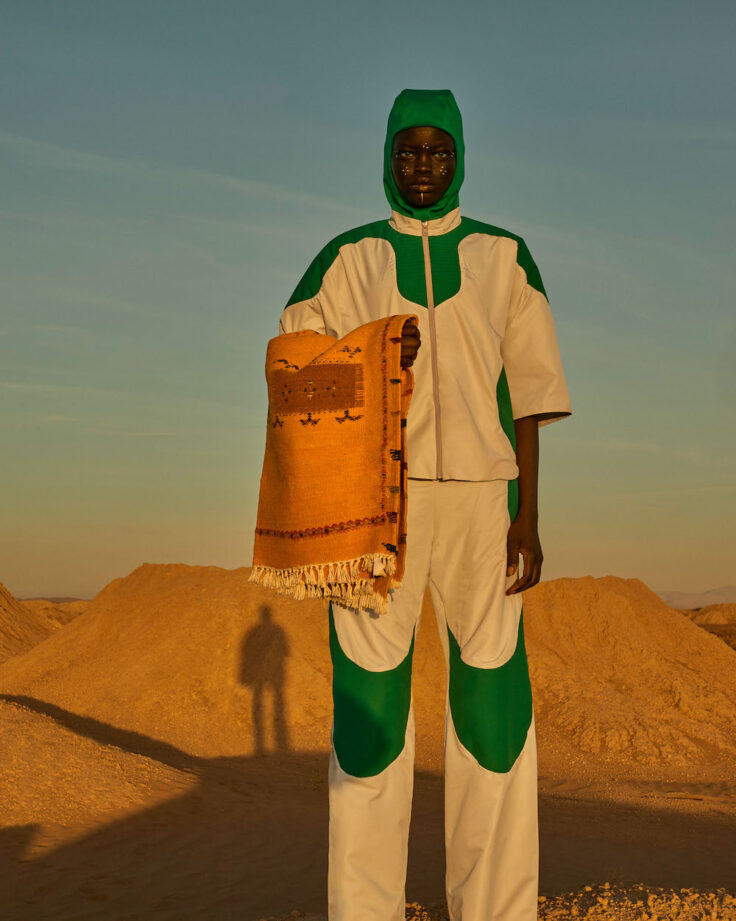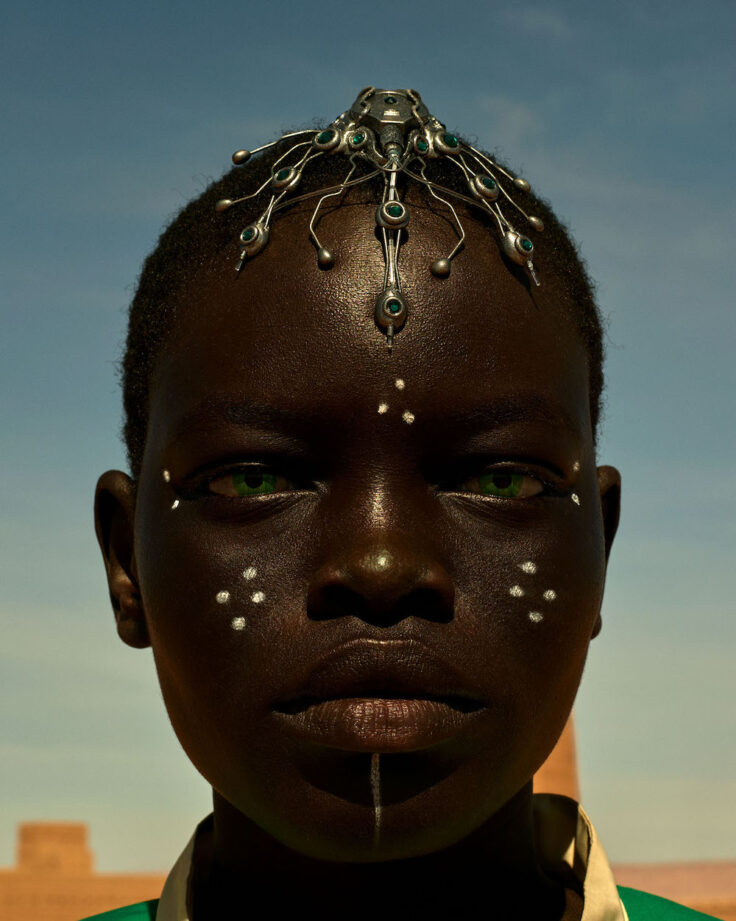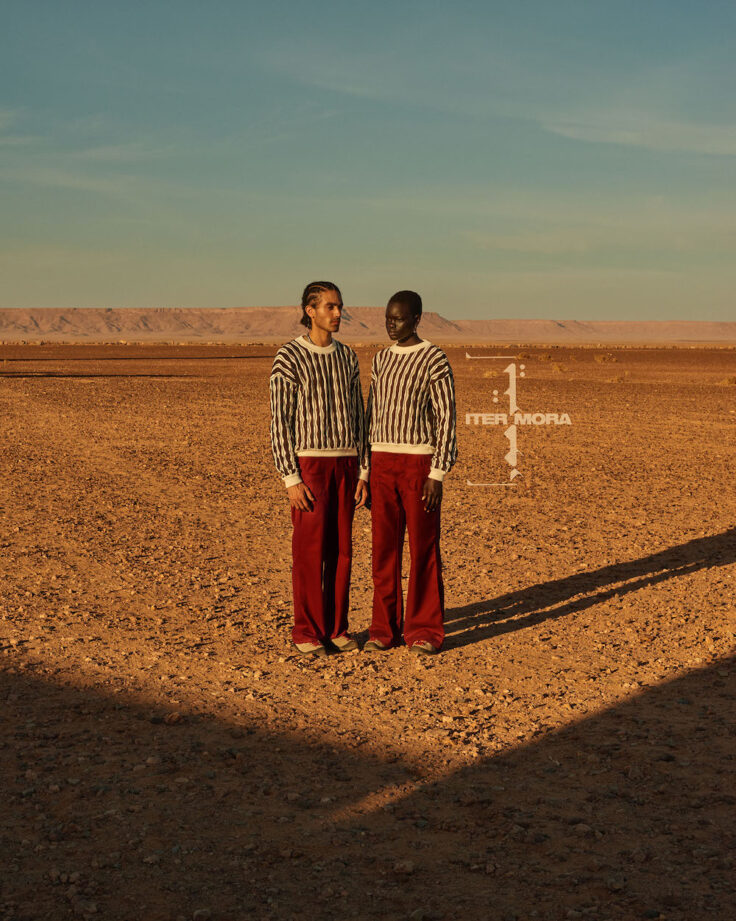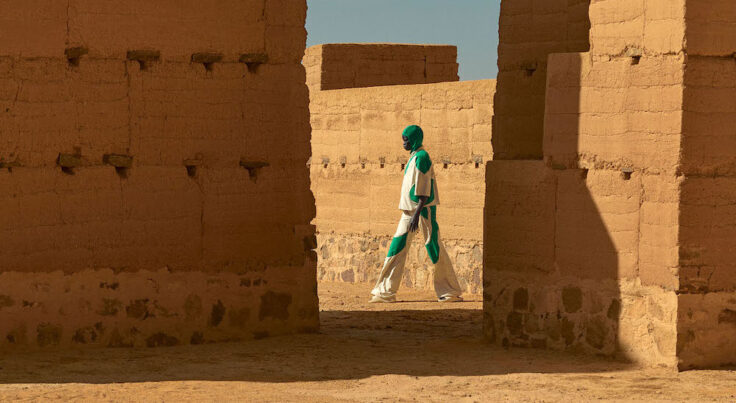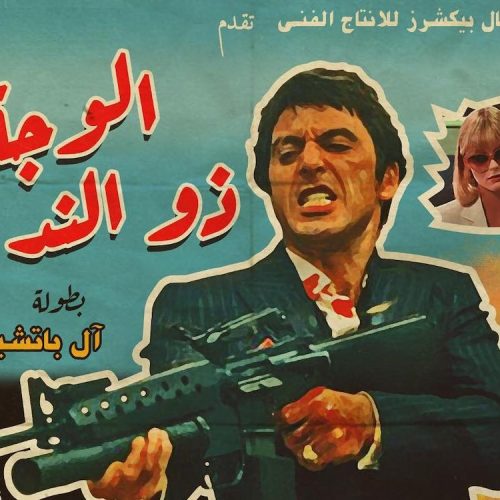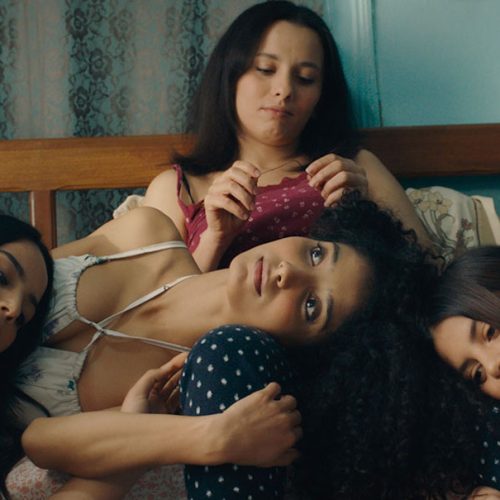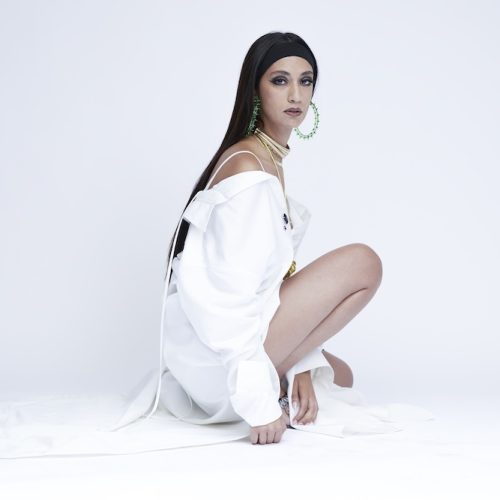In the crossroads of fashion and cinema stands ITER MORA, the brainchild of Elias Riadi. The London-based Moroccan-Cypriot’s new brand, which launched only a couple of months ago with a collection dubbed Orion Au Sahara 2970, transcends time and space, seamlessly blending the past and future, while putting the spotlight on North Africa.
The name ITER MORA echoes the parallel existence of the past and future in the present with “ITER” symbolizing journey and passage, and “MORA” indicating the duration of time. A mystical phonetic sound drawn from ancient languages, the brand’s name reflects Riadi’s enduring fascination with space-time and desire to showcase the region’s ancient astronomical history from a non-Western lens.
The debut collection of futuristic knitwear, headpieces, crewnecks, and flared trousers was unveiled by way of an artful campaign and an enchanting upcoming short film titled The City of Orion. While the 26-year-old, who is one of the four founding members of PAQ, an online fashion TV show, has had plenty of on-screen experience, the unreleased short film marks a departure from being in front of the camera to on the director’s chair so he can delve deeper into his Amazigh roots and, as he puts it, “tell a new story, one that should but has yet to be told.”
The campaign images and accompanying one-minute-and-eight-second-long video narrate a story that weaves through human civilization’s diverse art, culture, and history from cave paintings and pyramids, to brutalism, space age design, and the billions of things in between. “Each of these can influence another, from the earliest star worship through stones and aligned structures referencing my own indigenous Amazigh history, to the era of ’60s space age with my love of film and retro sci-fi. A fusion of both connections of the universe to two very different times in history, but both speaking to the wonder, connection, and fascination of the same thing: the stars,” explains the multi-hyphenate who was chosen as one of the British Fashion Council’s crop of New Wave Creatives.
Stadt des Orion, an art installation built by German artist Hannsjörg Voth between 1998 and 2003 in the Moroccan desert where the collection was shot, serves as the foundational canvas for Riadi’s narrative. The towering mud observatory in the middle of the Sahara, aligned with the constellation Orion, merges Morocco’s rich history, science fiction, and astronomy, creating a visual narrative that transcends time and culture.
Securing the location was a year-long journey, a testament to Riadi’s relentless determination to tell a story that is both culturally significant and visually stunning. “It was the channel that I needed to speak through for us Amazigh and our intricately woven ancestral ties to the celestial realm,” explained the young creative. “It allowed me to design a collection that brought the location to life to create garments that I imagined being draped on the inhabitants of those living within its towering desert walls.”
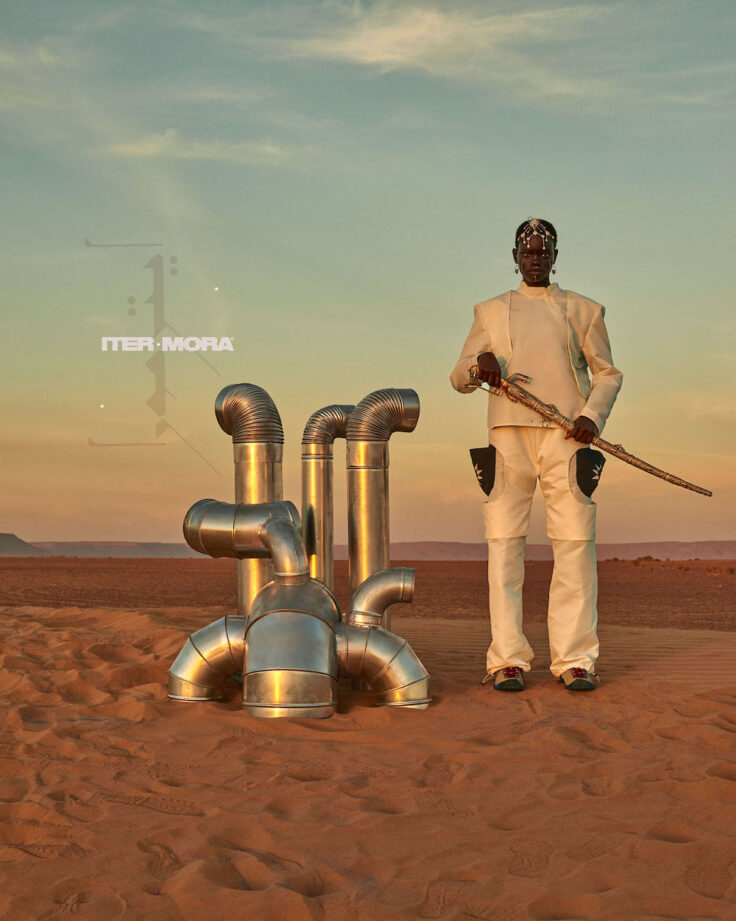
ITER MORA goes beyond fashion; it’s a cultural statement. “Growing up in the western world with zero North African representation and no aspirational figures to look up to and connect with was very alienating, which is precisely why ITER MORA holds profound significance for me,” muses Riadi. “It stands as a pure representation, a narrative that I yearned for and now have the opportunity to tell both myself and my community. Ensuring it not only translates to us but resonates through us, with complete ownership of the narrative,” he added.
Riadi, driven by the absence of proper representation, meticulously researched and authentically showcased the region’s ancestral history of astronomy and indigenous cultures, paying real homage to ancient North African traditions, with nods to indigenous face tattoos, motifs, make-up, and a local cast and crew, to resonate with the community that is often overlooked and seldom reflected. For instance, the technical desert suits, inspired by Moroccan djellabas and desert observatory towers, come in an indigo colorway to represent the Tuaregs, who were known as the “blue people” due to the indigo dye used on their robes, which often transferred and left a blue hue on their skin.
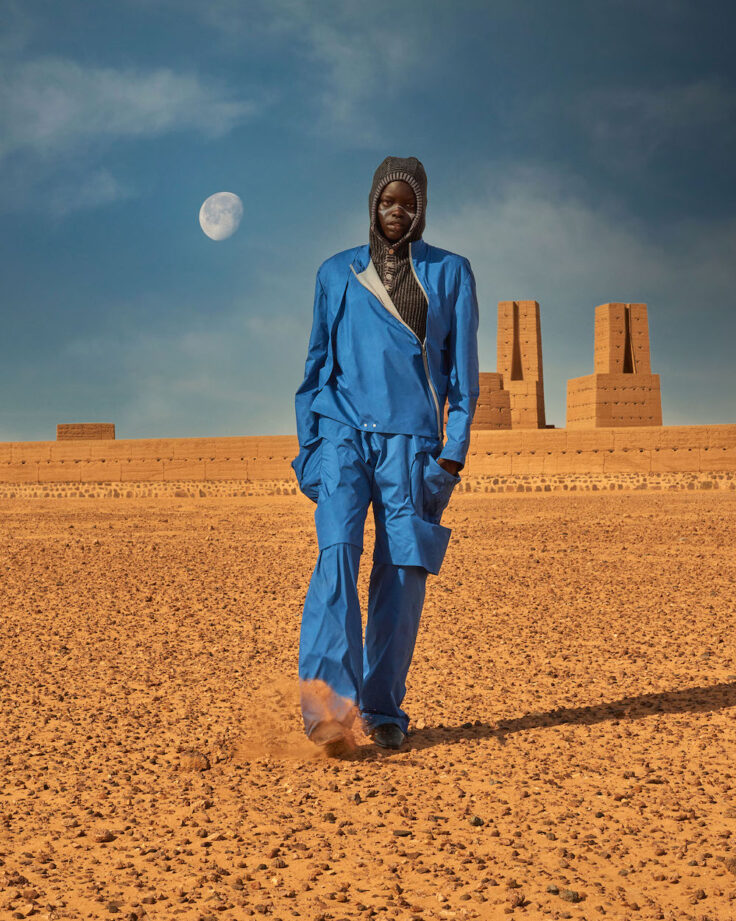
It was important for Riadi to infuse the heritage of the semi-nomadic ethnic group inhabiting the Sahara into his garments. “Tuaregs live in one of the most inhospitable areas of the planet. Their whole existence is rooted in strength, dominated by the need to protect and defend themselves from the harsh desert environment and hostile supernatural forces that inhabit their surroundings. So it was imperative that within the designs it spoke to that strength,” he said.
This was most obvious with the technical desert veil, referencing the traditional face coverings worn by Tuaregs to protect them from the harsh desert sands, while warding off evil spirits by covering the access to their soul. “Transforming the cotton veil into a futuristic iteration, structured and made out of a laser-cut technical fabric breathed new life into age-old wisdom whilst serving as a new form of protection, one for this planet and beyond,” stated the designer and filmmaker.
Technology played a pivotal role in translating Riadi’s vision into reality. The use of 3D rendering software and laser-cut fabrics allowed for unparalleled experimentation, offering insights and control beyond traditional design boundaries. Witnessing garments materialize in real-time empowers the budding designer and filmmaker to refine and perfect each piece before it’s even cut or sewn. “If something didn’t look quite right, or I wanted to see more variations of how to improve it, the pattern could be adjusted on the software, or by moving the way it sits on the avatar endless times until the desired look was achieved,” he explained.
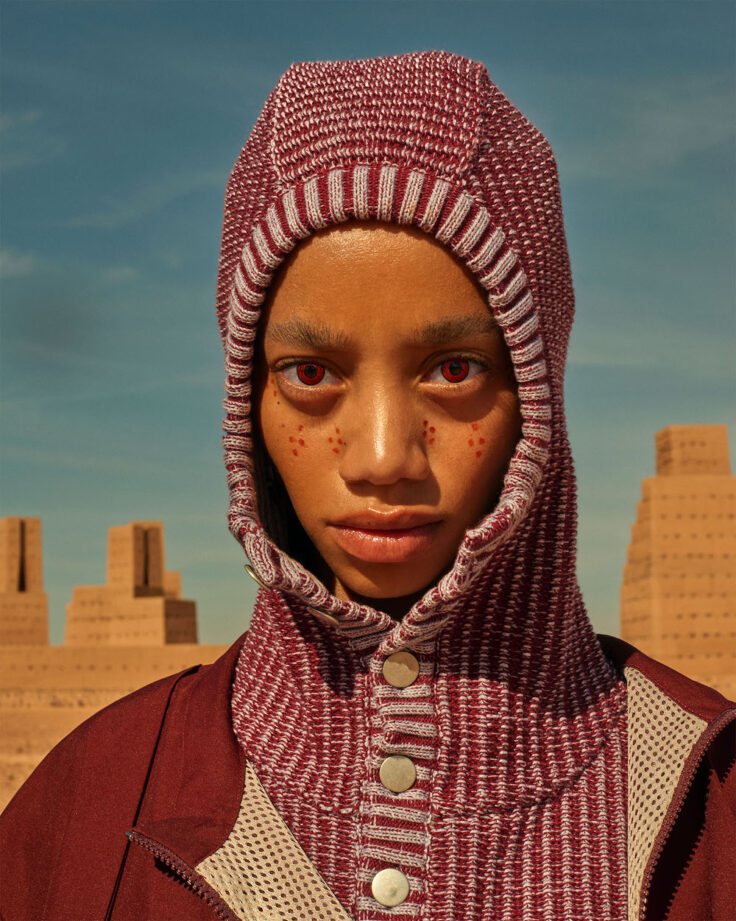
Ultimately, ITER MORA isn’t just a collection. It’s a self-funded investment and directorial debut, transcending both fashion and film, that stands as a testament to reclaiming cultural landscapes and storytelling through indigenous narratives. The garments contribute to the storytelling, with Riadi drawing inspiration from iconic designers like Jean Paul Gaultier, who crafted the costumes for the film Fifth Element, emphasizing the profound link between fashion and cinema.
“One of my biggest inspirations is film, it has played one of the major parts in shaping the dreamer that I am today and will be in the future, especially sci-fi and fantasy,” reflects Riadi. “Growing up watching films like Star Wars and even the story of Dune, which felt so familiar yet so distant due to the fact of it being heavily inspired by the North African spirit, proved it was time to reclaim our cultural landscape and story tell through our own indigenous narrative,” he adds.
As The City of Orion enters its final stages of post-production, Riadi’s vision is set to captivate film festivals next year, a “new chapter” he “couldn’t be more excited for.”
